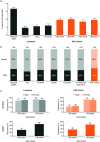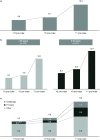High levels of healthcare utilization prior to diagnosis in idiopathic pulmonary arterial hypertension support the feasibility of an early diagnosis algorithm: the SPHInX project
- PMID: 30187824
- PMCID: PMC6311599
- DOI: 10.1177/2045894018798613
High levels of healthcare utilization prior to diagnosis in idiopathic pulmonary arterial hypertension support the feasibility of an early diagnosis algorithm: the SPHInX project
Abstract
Idiopathic pulmonary arterial hypertension (iPAH) is a rare progressive, life-shortening disease, usually diagnosed at an advanced stage. We hypothesize that patients with iPAH exhibit patterns of health-seeking behavior before diagnosis that will allow the development of earlier identification tools. The Sheffield Pulmonary Hypertension IndeX (SPHInX) project aims to develop a predictive algorithm based on routinely collected healthcare resource utilization (HCRU) data. This report focuses on the initial feasibility of the project, examining whether Hospital Episode Statistics (HES) data from the National Health Service in England have sufficient richness to support the development of an early diagnosis algorithm. This is a two-stage study. First, hospital interactions during 2009-2014 captured in HES data identified 127,815 adult patients with pulmonary hypertension (PH) ICD-10 codes, containing a probable iPAH cohort with incidence and demographics similar to the reported literature. HCRU was high in the three years before diagnosis. Second, to examine HCRU in patients with a confirmed iPAH diagnosis, we built the SPHInX dataset incorporating all patients investigated for suspected PH in the Sheffield Pulmonary Vascular Disease Unit during 2008-2016 (n = 6674). For the SPHInX dataset, data could be linked to HES in 98.6% of cases and patients with confirmed iPAH had similar levels of pre-diagnosis HCRU. In conclusion, patients with probable iPAH identified using HES and patients with confirmed iPAH have high levels of HCRU for several years before diagnosis. Artificial intelligence models will now be used to develop the SPHInX algorithm to screen for undiagnosed iPAH in the general population.
Keywords: Hospital Episode Statistics; diagnosis; idiopathic pulmonary arterial hypertension; real-world data; right heart catheterization.
Figures




References
-
- Humbert M, Morrell NW, Archer SL, et al. Cellular and molecular pathobiology of pulmonary arterial hypertension. J Am Coll Cardiol 2004; 43: 13S–24S. - PubMed
-
- Simonneau G, Gatzoulis MA, Adatia I, et al. Updated clinical classification of pulmonary hypertension. J Am Coll Cardiol 2013; 62: D34–41. - PubMed
-
- Humbert M, Sitbon O, Chaouat A, et al. Pulmonary arterial hypertension in France: results from a national registry. Am J Respir Crit Care Med 2006; 173: 1023–1030. - PubMed
-
- Lau EMT, Giannoulatou E, Celermajer DS, et al. Epidemiology and treatment of pulmonary arterial hypertension. Nat Rev Cardiol 2017; 14: 603–614. - PubMed
-
- Peacock AJ, Murphy NF, McMurray JJ, et al. An epidemiological study of pulmonary arterial hypertension. Eur Respir J 2007; 30: 104–109. - PubMed
Grants and funding
LinkOut - more resources
Full Text Sources
Other Literature Sources

